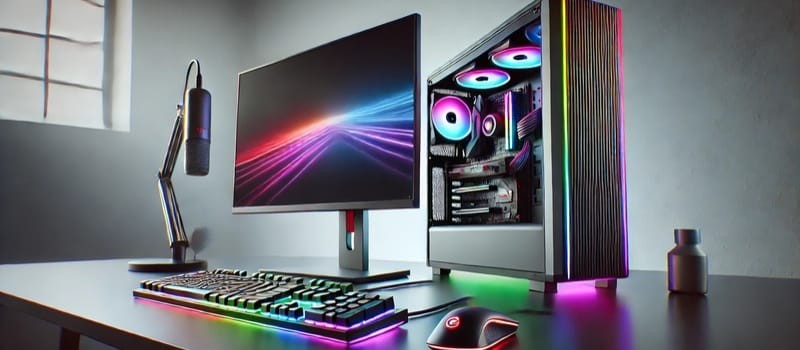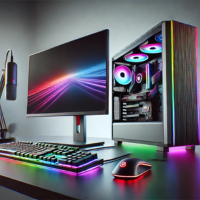Dalam industri yang mengandalkan kinerja tinggi, seperti desain grafis, animasi 3D, dan analisis data, workstation sering kali dihadapkan pada beban kerja yang berat. Ini membuat workstation menjadi panas dengan cepat, dan suhu yang terlalu tinggi dapat berdampak pada kinerja dan umur komponen. Berikut adalah lima opsi pendinginan terbaik untuk menjaga performa workstation Anda tetap stabil.
1. Pendingin Udara (Air Cooling)
Pendingin udara adalah salah satu opsi paling umum dan ekonomis untuk workstation. Dengan menggunakan kipas dan heatsink, sistem ini dapat mengalirkan udara dingin ke dalam casing dan mengeluarkan udara panas dari komponen seperti CPU dan GPU. Pendingin udara cocok untuk workstation dengan beban kerja sedang, dan dengan kipas berkualitas tinggi, pendinginan ini dapat bekerja efektif untuk menjaga suhu tetap stabil. Pastikan ventilasi casing terbuka dan bebas dari debu untuk hasil maksimal.
2. Pendingin Cair (Liquid Cooling)
Liquid cooling adalah solusi pendinginan yang lebih canggih dan efektif untuk workstation yang bekerja dengan beban berat. Sistem ini menggunakan cairan untuk menyerap panas dan mendinginkan komponen. Cairan tersebut kemudian didinginkan di radiator sebelum berputar kembali ke komponen utama. Liquid cooling menawarkan suhu yang lebih rendah dan stabil dibandingkan pendingin udara, sehingga ideal untuk workstation yang sering melakukan rendering, simulasi, atau tugas intensif lainnya. Selain itu, liquid cooling cenderung lebih senyap, menjaga lingkungan kerja tetap nyaman.
3. Heat Pipe Cooling
Pendinginan berbasis heat pipe menggunakan pipa yang mengandung cairan untuk menyerap panas dari komponen dan mendistribusikannya ke heatsink atau kipas. Teknologi ini cukup efektif untuk workstation, karena heat pipe dapat menyalurkan panas dengan cepat dari area yang panas, seperti CPU atau GPU. Heat pipe cooling adalah opsi yang efisien dan hemat energi untuk menjaga suhu komponen tetap terkontrol, terutama jika dipadukan dengan kipas pendingin berkualitas tinggi.
4. Sistem Pendingin Hybrid (Hybrid Cooling)
Sistem pendingin hybrid menggabungkan teknologi pendingin udara dan pendingin cair, memberikan solusi yang sangat efektif untuk workstation. Dalam sistem ini, heatsink atau heat pipe bekerja bersama dengan cairan pendingin untuk memaksimalkan penyerapan panas dan mencegah komponen terlalu panas. Pendingin hybrid sangat cocok untuk workstation yang membutuhkan kinerja tinggi dalam jangka panjang, karena dapat menstabilkan suhu dengan lebih efektif dibandingkan satu sistem pendingin saja.
5. Liquid Nitrogen Cooling
Liquid nitrogen cooling adalah opsi ekstrem yang sering digunakan untuk overclocking atau pengujian kinerja workstation pada tingkat tertinggi. Sistem ini menggunakan nitrogen cair, yang memiliki suhu sangat rendah, untuk mendinginkan komponen dengan cepat. Meski sangat efektif, pendingin nitrogen cair hanya digunakan untuk aplikasi khusus, karena pemasangannya rumit dan memerlukan pemantauan yang ketat. Bagi pengguna workstation biasa, opsi ini mungkin kurang praktis, tetapi sangat membantu untuk keperluan pengujian atau tugas yang membutuhkan pendinginan ekstrem.
Setiap opsi pendinginan memiliki kelebihan dan kekurangan, tergantung pada kebutuhan dan beban kerja workstation Anda. Pendingin udara dan heat pipe cocok untuk beban kerja sedang, sementara liquid cooling dan sistem hybrid menawarkan solusi lebih baik untuk beban kerja berat. Untuk tugas-tugas intensif tertentu, liquid nitrogen cooling bisa menjadi pilihan ekstrim yang efektif.
Jika Anda ingin menjaga performa workstation tetap optimal dengan solusi pendinginan terbaik, Thrive hadir dengan teknologi ET PC Desktop Workstation yang mendukung berbagai opsi pendinginan sesuai kebutuhan Anda. Dengan dukungan teknologi mutakhir, Thrive siap membantu Anda mencapai efisiensi dan stabilitas kinerja workstation. Hubungi kami sekarang untuk konsultasi lebih lanjut tentang solusi workstation dan pendinginan yang sesuai untuk Anda!




























 Industrial Robotics Integration
Industrial Robotics Integration
 IT Outsourcing Service
IT Outsourcing Service
 Secure Internet SD-WAN Connection
Secure Internet SD-WAN Connection
 Digital Marketing Service
Digital Marketing Service









